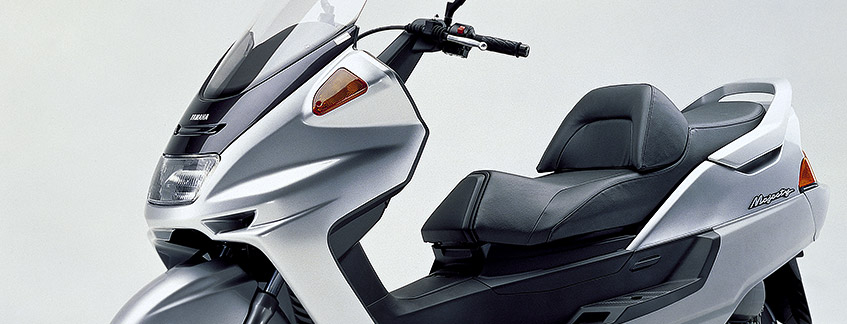At the beginning of the 1990s, scooters with 125 cc or larger engines were quite popular. These included Yamaha's light scooter, the Cygnus, which the company first marketed in 1982. Yamaha conducted market surveys in order to assess the market potential of this segment and the results showed that most demand lay in the three metropolitan areas of Tokyo, Osaka, and Nagoya, where the main use was for commuting to work. It was also evident that there was potential for further growth.
In light of this information, Yamaha decided to release new models in this segment. The process started with development staff actually testing and comparing various commuting routes. On an approximately 20 km route from Machida on the outskirts of Tokyo to Shibuya in the city center, tests were run on each mode of transport available. The developers compared bicycles, scooters, motorcycles, and combinations of trains and buses, and found that motorcycles were much faster than the other options. Moreover, other modes of transport provided no comparison when it came to the flexibility with respect to time offered by commuting on a motorcycle, which constituted another reason for its superiority.
However, riding a distance of some 20 km through rush-hour traffic on a motorcycle or scooter is not an easy undertaking, and the test riders all felt quite tired after finishing the commute. Given these considerations, the development staff concluded that an automatic 250 cc scooter would be the best option for safely commuting a similar distance on a daily basis.
Yamaha wanted to completely remake conventional images associated with scooters by making the new model a refined scooter that combined comfort and sportiness. It was targeted for commuter use, but it needed more than just practical features so it could be enjoyed for weekend cruising as well. The developers therefore paid particular attention to comfort levels over long distances.
The engine was an extremely quiet liquid-cooled 250 cc 4-stroke single-cylinder model. An automatic transmission requiring no shifting was adopted and the scooter could be operated easily using just the accelerator and brakes. The company put priority on comfort, which resulted in the use of 12-inch wheels, a first for 250 cc class scooters. Attention was paid to the usability of the seat as well. It featured an adjustable backrest and plenty of storage underneath. With an aerodynamically superior fairing and other features, this model offered a sporty look that went well beyond conventional conceptions of scooters.


The Majesty 250 was put on the market in August 1995. Its comfort and sporty design attracted much attention, and it became an overnight hit. Yamaha initially projected annual production to be 3,000 units, but the product was so popular that production rose to over 10,000 units per year, dramatically exceeding expectations. The Majesty found a receptive audience overseas as well, creating new demand there. Sales in Europe first surpassed domestic totals in 1996 and by 2000 had risen to over 20,000 units.


As domestic demand for motorcycles and scooters began to decline somewhat in the 1990s, Yamaha products proved to be popular in other product categories as well. Strong sellers included the Vino, a retro-style scooter marketed utilizing the female pop duo Puffy, the Drag Star XVS400, an American-style bike with Japanese sensibilities that had a long, low profile, and the Serow 225, a trail bike in the "mountain trail" genre that already had a long history of good sales. The long-selling "big single" SR400 also experienced rekindled popularity in the 1990s.


.










